Marrying Vega and Zen: The AMD Ryzen 5 2400G Review
by Ian Cutress on February 12, 2018 9:00 AM ESTBenchmarking Performance: CPU Encoding Tests
One of the interesting elements on modern processors is encoding performance. This includes encryption/decryption, as well as video transcoding from one video format to another. In the encrypt/decrypt scenario, this remains pertinent to on-the-fly encryption of sensitive data - a process by which more modern devices are leaning to for software security. Video transcoding as a tool to adjust the quality, file size and resolution of a video file has boomed in recent years, such as providing the optimum video for devices before consumption, or for game streamers who are wanting to upload the output from their video camera in real-time. As we move into live 3D video, this task will only get more strenuous, and it turns out that the performance of certain algorithms is a function of the input/output of the content.
All of our benchmark results can also be found in our benchmark engine, Bench.
7-Zip 9.2: link
One of the freeware compression tools that offers good scaling performance between processors is 7-Zip. It runs under an open-source licence, is fast, and easy to use tool for power users. We run the benchmark mode via the command line for four loops and take the output score.
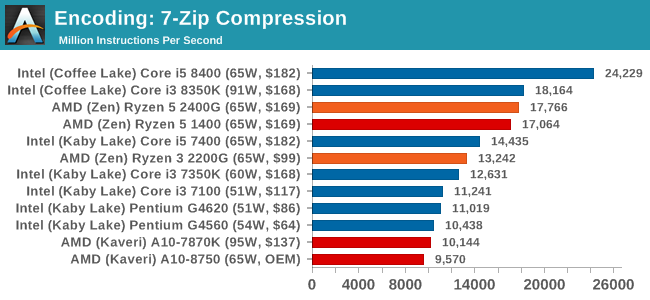
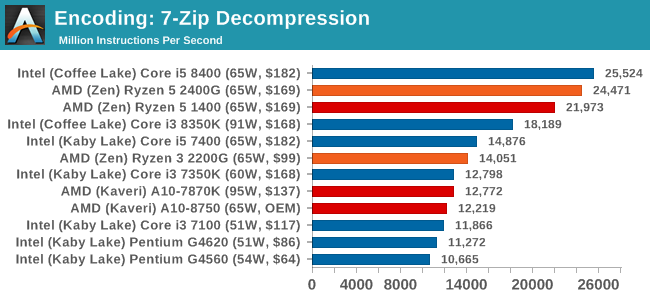
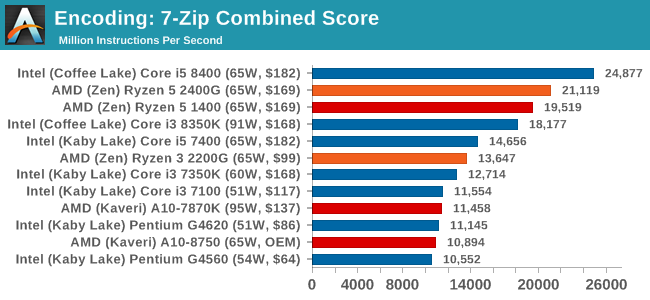
7-zip gives two contrasting stories here. For compression, full cores are needed to get the best performance, with frequency helping as well. However, for decompression, the extra threads help a lot. The combined result looks more like the decompression score, with the Ryzen 5 2400G sitting between the six-core Core i5-8400 and the quad-core Core i3-8350K.
WinRAR 5.40: link
For the 2017 test suite, we move to the latest version of WinRAR in our compression test. WinRAR in some quarters is more user friendly that 7-Zip, hence its inclusion. Rather than use a benchmark mode as we did with 7-Zip, here we take a set of files representative of a generic stack (33 video files in 1.37 GB, 2834 smaller website files in 370 folders in 150 MB) of compressible and incompressible formats. The results shown are the time taken to encode the file. Due to DRAM caching, we run the test 10 times and take the average of the last five runs when the benchmark is in a steady state.
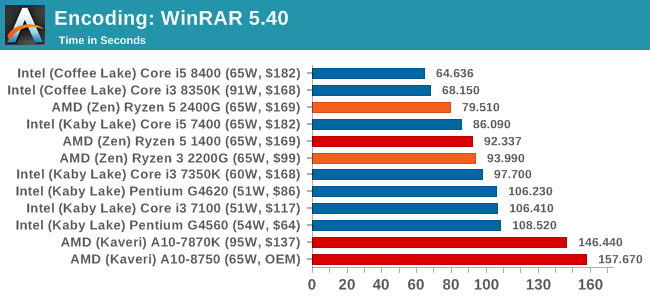
WinRAR is a good scaler with cores, frequency, and memory performance. The eight threads and DDR4-2933 contributes a good amount to the performance here, especially in light of where AMD was. The jump from the Ryzen 5 1400 to the 2400G is also noticable, due to the uptick in frequency and memory speed. The high single-thread performance of the Intel cores still wins out, however.
AES Encoding
Algorithms using AES coding have spread far and wide as a ubiquitous tool for encryption. Again, this is another CPU limited test, and modern CPUs have special AES pathways to accelerate their performance. We often see scaling in both frequency and cores with this benchmark. We use the latest version of TrueCrypt and run its benchmark mode over 1GB of in-DRAM data. Results shown are the GB/s average of encryption and decryption.
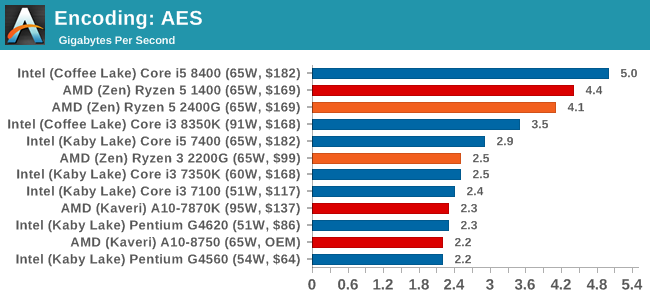
HandBrake v1.0.2 H264 and HEVC: link
As mentioned above, video transcoding (both encode and decode) is a hot topic in performance metrics as more and more content is being created. First consideration is the standard in which the video is encoded, which can be lossless or lossy, trade performance for file-size, trade quality for file-size, or all of the above can increase encoding rates to help accelerate decoding rates. Alongside Google's favorite codec, VP9, there are two others that are taking hold: H264, the older codec, is practically everywhere and is designed to be optimized for 1080p video, and HEVC (or H265) that is aimed to provide the same quality as H264 but at a lower file-size (or better quality for the same size). HEVC is important as 4K is streamed over the air, meaning less bits need to be transferred for the same quality content.
Handbrake is a favored tool for transcoding, and so our test regime takes care of three areas.
Low Quality/Resolution H264: Here we transcode a 640x266 H264 rip of a 2 hour film, and change the encoding from Main profile to High profile, using the very-fast preset.
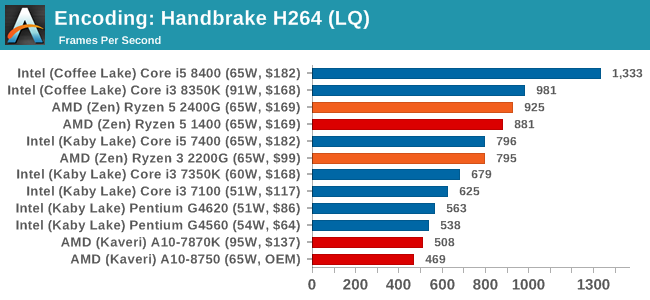
High Quality/Resolution H264: A similar test, but this time we take a ten-minute double 4K (3840x4320) file running at 60 Hz and transcode from Main to High, using the very-fast preset.
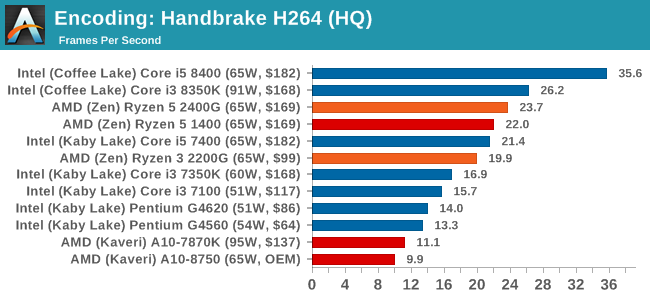
HEVC Test: Using the same video in HQ, we change the resolution and codec of the original video from 4K60 in H264 into 4K60 HEVC.
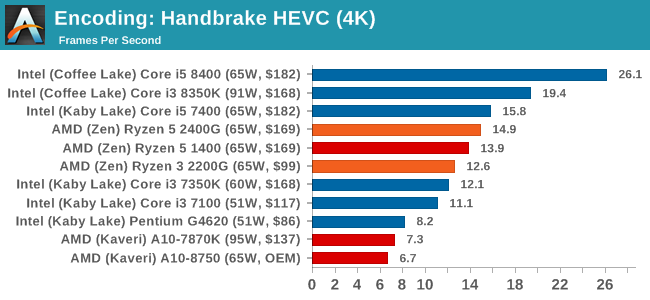










177 Comments
View All Comments
AndrewJacksonZA - Monday, February 12, 2018 - link
Hi Ian. I'm still on page one but I'm so excited! Can a 4xx Polaris card be Crossfired with this APU?prtskg - Tuesday, February 13, 2018 - link
No crossfire supported by these apus, according to AMD. You can check it out on AMD's product page.dgingeri - Monday, February 12, 2018 - link
How many PCIe lanes are available on them? I didn't see that info anywhere in the article.iter - Monday, February 12, 2018 - link
Only 8dgingeri - Monday, February 12, 2018 - link
Well, not great, but it can still run a RAID controller off the CPU lanes and a single port of 10Gbe from the chipset, or run a dual port 10Gbe from the CPU and a lower end SATA HBA from PCIex4 from the chipset with software RAID. The 2200G could make a decent storage server with a decent B350 board. I could do more with 16 lanes, but 8 is still workable. It's far cheaper than running a Ryzen 1200 with a X370 board and a graphics card with the same amount of lanes available for IO use and a faster CPU.Geranium - Monday, February 12, 2018 - link
8 PCIe Gen3 for gpu+4 Gen3 for SSD+4 Gen3 for Chipset.andrewaggb - Monday, February 12, 2018 - link
What's with the gaming benchmarks... Is there a valid reason that no games were benchmarked at playable settings? I'm going to have to go to another site to find out if these can get 60ish fps on medium or low settings.... And I thought these were being pitched at esports... so some overwatch and dota numbers might have been appropriate.AndrewJacksonZA - Monday, February 12, 2018 - link
"and can post 1920x1080 gaming results above 49 FPS in titles such as Battlefield One, Overwatch, Rocket League, and Skyrim, having 2x to 3x higher framerates than Intel’s integrated graphics. This is a claim we can confirm in this review.""These games are a cross of mix of eSports and high-end titles, and to be honest, we have pushed the quality settings up higher than most people would expect for this level of integrated graphics: most benchmarks hit around 25-30 FPS average with the best IGP solutions, down to 1/3 this with the worst solutions. The best results show that integrated graphics are certainly capable with the right settings, but also shows that there is a long way between integrated graphics and a mid-range discrete graphics option."
I would love to see which settings BF1 would have 49FPS please. Is it with everything on low, medium?
Ian Cutress - Monday, February 12, 2018 - link
I've added some sentences to the IGP page while I'm on the road. We used our 1080 high/ultra CPU Gaming suite for two reasons.Manch - Monday, February 12, 2018 - link
Which are?